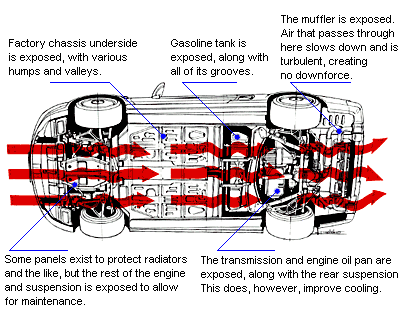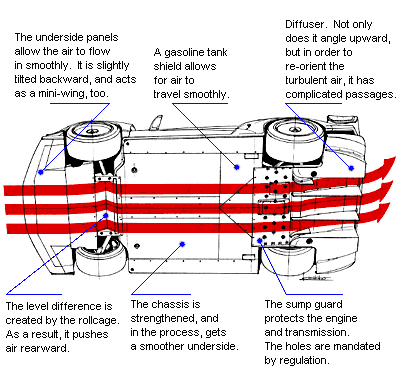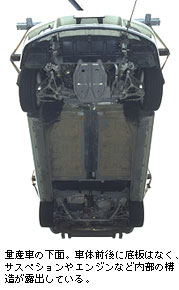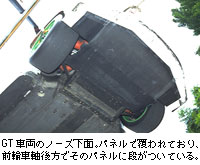This is an english translation of an original japanese article by Honda of Japan. The rights to this english translation belong to the Temple of VTEC Asia. All contents of this article are the intellectual property of Honda of Japan. Please refer to the main index page for further details.

Learn of the Secrets Unseen From the Grandstands
Volume 1 - Turn the NSX Over
Lecturer: Akie Oku
*The Secret Hidden on the Other Side
All race cars are slim, stylish, and streamlined. This is so it can streak through air faster. Common wisdom suggests that the lower the air resistance, the faster one can go. However, for the modern-day race car, simple air resistance is not all there is to be concerned about. Air can be used to improve maneuverability. In other words, avoiding the air is important, but a key design feature falls upon how the air can be used aggressively in our favor.
The GT version NSX is no exception. Matter of fact, one of the GT version NSX's themes/goals and mindset was "To obtain a higher air performance than its rivals." In this volume, I would like to highlight the most unique and effective design considerations for the GT version NSX. Indeed, the GT version NSX has a slender body and a large wing. But instead, let us not concentrate on those things, but rather, an area that we rarely get to see -- its underside.
*Air That Works Underneath the Car
Let us compare the factory NSX with the GT version NSX from the underside. The most obvious difference is how the factory NSX has the suspension, engine, fuel tank, transmission, etc., exposed -- whereas the GT version NSX has them all covered. Upon close examination, these panels are not simply flat -- they contain dimples and grooves. This is the key point.
When a car drives above a road, air flows around the body. Slender bodies and large wings are all result of efforts to let the air above the body flow smoothly, and use the air to cause downward force (ie, downforce) in order to improve maneuverability. However, the air flows underneath the car as well -- even in that small gap. The GT version NSX's key airflow design was here.
[Factory NSX's Underside]
[GT version NSX's Underside]
In the small space in-between the bottom of the car and the road, the airflow plays many tricks. With too much airflow on the underside, the pressure in that area increases, and results in the car being pressed upward -- reducing maneuverability. The reason why the factory NSX's underside does not use panels, and has large gaps is to allow the air under the body to escape.
However, the GT version NSX is designed to aggressively make use of the air that flows underneath, and therefore, covers its entire underside with panels. Contrary to having too much pressure on the underside, it is possible to lower the pressure on the underside if the airflow is directed rearward smoothly. In such an instance, an area of low pressure is born, and sucks the car's body towards the ground, giving it more downforce. This is known as "ground effect". (ironic, how that word equates to "body kit" in the US - ed.) A lifeline of a true race car depends on how well it can make use of the ground effect.. However, the ground effect is a true double-edge sword. As stated above, simply moving more air under the car is not going to help unless that air can be streamlined to the back and out. Only then is downforce born.

*Advantages of the MR
While developing the GT version NSX, numerous wind tunnel experiments were performed to determine the ideal shape/form of the underbody panel layout. The front, nose area pointed slightly upward, and is rounded, just like the Formula 1 GrandPrix car's front wing. From here, airflow is directed downward without adding any disturbance. With the factory NSX, the suspension protrudes beyond that, but with the GT version, additional panels re-direct the air back under the car. I would like to point out that right around where the front wheel fenderwell ends and meets the cabin area, there is an extra valley-shaped step opposing forward motion.
|

|
| The underside of a factory NSX. No flat, underside panels are installed, but instead, many parts are exposed. |
| This extra valley aids in increasing the speed of the airflow
under the car. This is a natural modification for full-blown race
cars, but typically, using such a design on a factory-based vehicle, and on
a front-engine model proves to be extremely challenging. Fortunately,
the NSX's engine is behind the driver's seat, and leaves ample room for such
bold design decisions.
Now, the air that passes the valley will pass underneath the cabin area. Factory NSX's simply have the fuel tank exposed, but the GT version NSX utilizes an optional, under-body cover for the fuel tank. This creates an additional smooth surface for the air to flow through. While it is a detailed consideration, it carries decent weight when considering ground effects. |

|
| GT version NSX's nose area. A lot of the area is covered by the panel, and there is an intentional valley in-between that and the next panel. |
*A Car That Gets Sucked to the Ground
Let's look rearward now. In the factory NSX, the engine's oil pan, transmission, rear suspension are all exposed. The GT version hides those parts with a panel with holes on it. The panel is installed as a means to protect the engine compartment, and is allowed by GT rules. However, in order to control ground effects performance gained, GT rules mandate that there be regulation-size holes in the panel in order to disturb airflow. The GT version NSX is compliant, but has adjusted the surrounding panels accordingly to restore airflow.
| The rearward panel angles up from its midpoint and beyond. Known as a diffuser, this panel directs the air flowing from below to above and behind. By adjusting the diffuser's angle or size, the airflow greatly changes, and so does ground effects performance. This is one of the key design points of vehicle design. Because of that, we would rather not show the entire world what the underside looks like. Still, today, we will show the underside to you, since simply copying the design would get you nowhere. | 
|
| GT version's tail area. Notice how it flares upward, and the sump cover has holes in it. |
In order for a car to maximize use of airflow, the underside of the car has to a) allow ample air in, b) allow air to flow smoothly, and c) allow the airflow to quickly/efficiently escape. The GT version NSX's underside design satisfies all 3 criteria. So... were you aware that the GT version NSX's speed lies in its underside? Well, there are more secrets to come...
| INDEX | ||
| NEXT |
Updated October 15, 1999